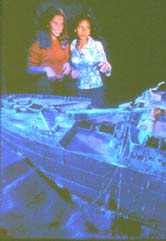You remember Titanic, right? The three hour-plus aqua epic that for many became a part-time job, and sparked an interest in undersea exploration. While Kate Winslet’s career may have fizzled and Leonardo DiCaprio has of late appeared in substandard fare like The Beach, the scouring of the vast watery deep continues.
And Liberty Science Center in Jersey City now has an exhibit that features the excitement of undersea exploration.
New life forms, thermal vents, close-up views of deep-sea research submersibles and that doomed luxury liner will all be on display at the LSC through Jan. 7, 2001.
Putting technology in the hand of the visitor is the aim of the exhibit, where someone can view the launching of the Alvin, a deep-sea submersible. Explorers will be able to operate a replica of the sphere and fly a remotely operated vehicle over a model of the Titanic’s deck.
You can test your skills by manipulating Alvin’s robotic arm by picking up lava rocks and clams from the sea floor while peering through a re-creation of Alvin’s four-inch viewport window.
Produced in collaboration with the Woods Hole Oceanographic Institution in Cape Cod, Mass., the exhibit teaches little-known facts.
It’s not a fish
Did you know that a jellyfish isn’t a fish? The 650-million year old creature is actually related to corals, is 94 percent water and is made up of nerves, muscles and stinging cells.
The exhibit reveals what lives well below the sea’s surface. The sun does not penetrate the water at these depths. The sea floor inhabitants live all their lives in complete and total darkness. They live and thrive on a unique and unexpected life support system, chemosynthesis, which takes the place of photosynthesis at such depths. You can see replicas of some of the scavenger crabs and sea anemones that survive in the deep.
And on Tuesday, Nov. 14, at 6:30 p.m., two experts will be taking visitors on an exploration of this vast unknown. Rutgers University professors Peter A. Rona and Richard Lutz will deliver a lecture on their ocean research.
Center spokeswoman Dina Schipper hopes that people come away from the exhibit with “a better or a deeper understanding” of science. She understands that children often “see it as an exhibit with buttons to push,” but she believes that the exhibit will spark curiosity.
The center isn’t finished with underwater exploration. Coming early next year, Liberty Bell 7 – a NASA spacecraft that was lost underwater in 1961 – will be coming to the center. The capsule was recovered from the sea floor in 1999.
Extreme Deep: Mission to the Abyss, will be on display until January 7, 2001. Call (201) 451-0006 for more information or visit on the web at www.lsc.org. “Dive to the Extreme Deep,” lecture by Peter A. Rona and Richard Lutz, will be on November 14, 2000 at 6:30 p.m. Call (201) 200-1000 to make a reservation.
